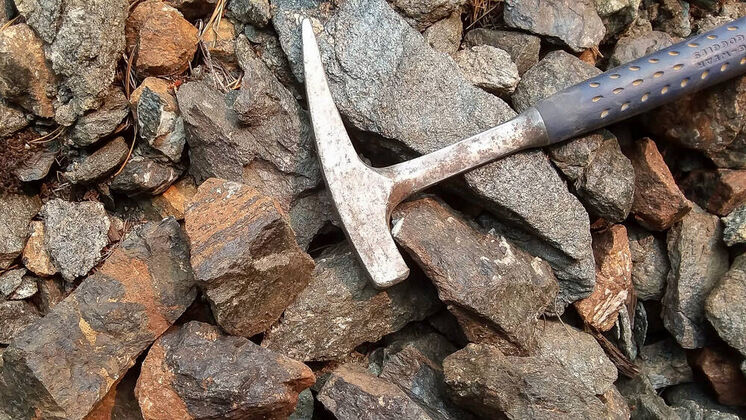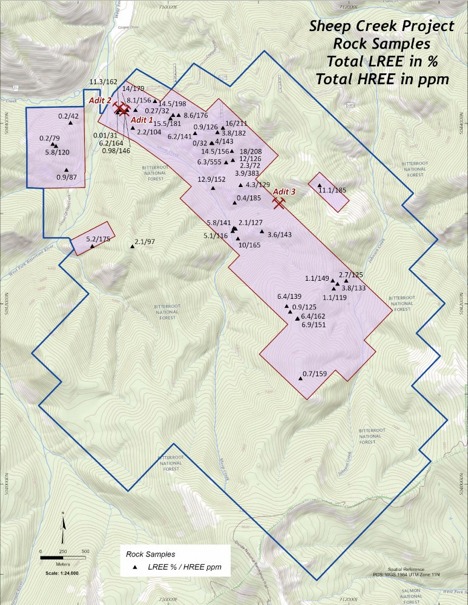Begins systematic investigation of overlooked rare earths project in SW Montana.
To gain a deeper understanding of the high-grade rare earth mineralization coming to surface at Sheep Creek, and investigate the potential for a larger deposit of this group of technology elements, US Critical Metals Corp. and US Critical Materials Corp. are carrying out detailed mapping and sampling of this overlooked and underexplored project in southwestern Montana.
While high-grade rare earths were identified at Sheep Creek while exploring for niobium on the property in the early 1960s, there were virtually no uses for these 15 elements at that time. As such, the property went largely unnoticed for the past six decades.
Today, rare earths are used in televisions, smartphones, computers, lasers, fiber optics, hydrogen fuel cells, and an array of other high-tech and household applications. The biggest driver of demand for this group of elements, however, is for the high-power magnets that make electric vehicle motors more efficient.
With the demand for rare earths on the rise and the United States seeking to establish domestic supplies of these critical minerals primarily produced in China, US Critical Materials staked claims covering more than 50 carbonatites at Sheep Creek enriched with rare earths and other critical minerals.
Earlier this year, British Columbia-based US Critical Metals entered into an agreement to earn up to a 75% joint venture interest in Sheep Creek and the Lemhi Pass rare earths project in southeastern Idaho by paying US Critical Materials US$500,000 in cash and investing US$9.5 million in exploration and other activities to advance the Montana project over the next five years.
“The investment by US Critical Metals gives US Critical Materials the financial strength to aggressively pursue the development of the Sheep Creek, Montana property,” US Critical Materials President James Hedrick said upon the July signing of the agreement.
Now, the partners have begun that pursuit.

Encouraging mineralogy
After expanding the Sheep Creek property from around 1,100 to 4,500 acres, the partners launched a fall exploration program that includes detailed mapping and sampling.
The limited modern exploration carried out so far at Sheep Creek has turned up 13 critical minerals – nine rare earth elements, gallium, niobium, scandium, and yttrium.
Samples collected by US Critical Materials on the original 1,100 acres of claims contain as much as 18% rare earth elements, indicating this southwestern Montana project could host some of the highest REE grades in the U.S.
What is particularly intriguing is the high percentage of neodymium and praseodymium, a pair of rare earths used to manufacture the powerful magnets for EV motors, wind turbine generators, and other products. Samples with as much as 2.4% combined neodymium and praseodymium have been collected from the Sheep Creek carbonatites.
The average total rare earth element content of 51 samples from Sheep Creek – 10 collected about a decade ago and 41 from US Critical Materials’ exploration in 2021 – is 6.8%, including an average of 0.86% combined neodymium and praseodymium.
Based on these samples, along with regional studies and the style of mineralization, Sheep Creek is believed to have similar mineralogy to significant rare earth deposits around the world.
The partners say the fenitization – alteration of rock under high heat and pressure that is related to a carbonatite or alkaline igneous rocks – and mineralization at Sheep Creek indicate the potential for a large body of carbonate magma buried below the surfacing rare earths. This type of mineralization is found at the giant Bayan Obo rare earths-niobium-iron deposit in Inner Mongolia, China.
“I am highly encouraged by the style of minerology present at Sheep Creek,” said Hedrick. “I believe this initial exploration program will provide valuable data to advance our geologic theory and objective of defining a new source of rare earths to address critically needed supply within the U.S.”
Defining drill targets
While there may be a much larger deposit feeding the dozens of carbonatite dikes found on the surface, the partners will take a top-down approach to exploring the high-grade critical mineralization at Sheep Creek.
This has begun with a fall program that includes detailed geological mapping and the collection of 500 rock and soil samples across the expanded project.
To gain a better understanding of the relative grade and distribution of critical minerals across the Sheep Creek property, the exploration team will collect samples from the carbonatite dikes along with areas across the property to fully characterize the lateral extent of REE mineralization and to investigate the potential for zonation of light and heavy rare earths.
Samples will also be collected from below ground from three adits dug during the 1960s era exploration for niobium at Sheep Creek, which includes 435 meters of underground workings. Sampling of the 122 meters of carbonatite dikes these drifts followed could strongly enhance the understanding of the mineralized system at Sheep Creek.
The mapping, along with geophysical surveys, will help narrow targets for drilling that is expected to begin next year.
“The work program for the project will build upon historical work and sampling, with the objective of delineating an initial set of drill targets,” said US Critical Metals CEO Darren Collins. “This phased exploration approach is consistent with USCM’s overall objective of bringing a portfolio of projects to drill ready stage and selectively drilling the highest priority targets. We look forward to advancing this asset alongside our partner.”
Also Published on MetalTech News: US Critical Materials explores Sheep Creek

